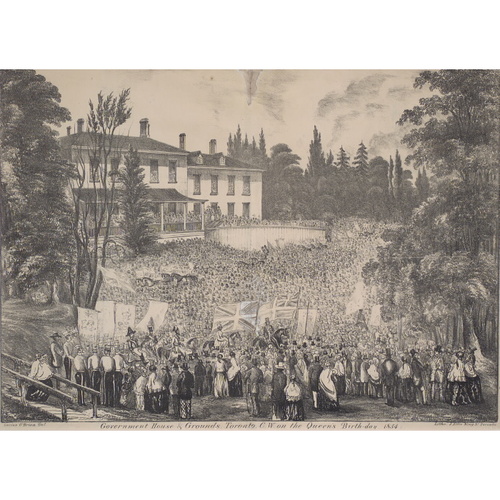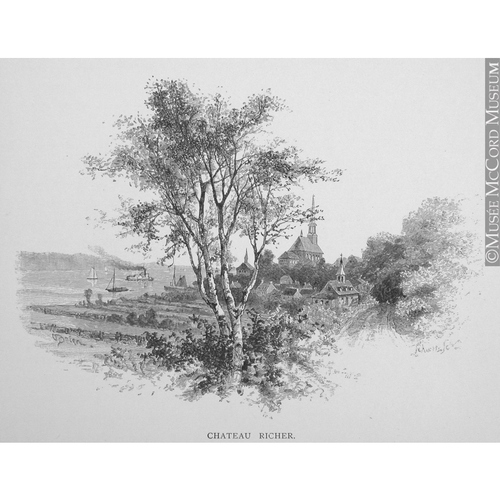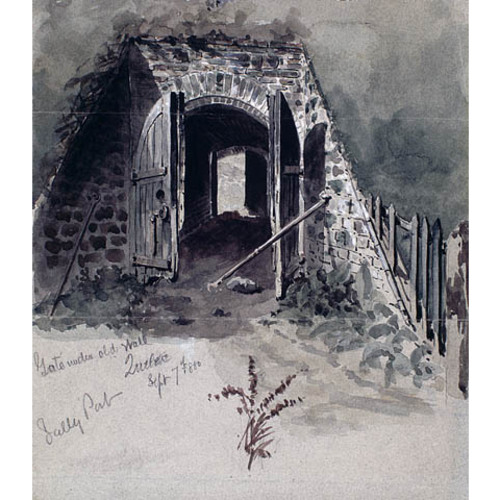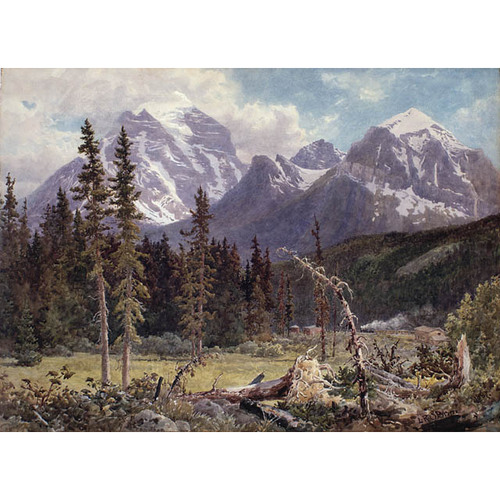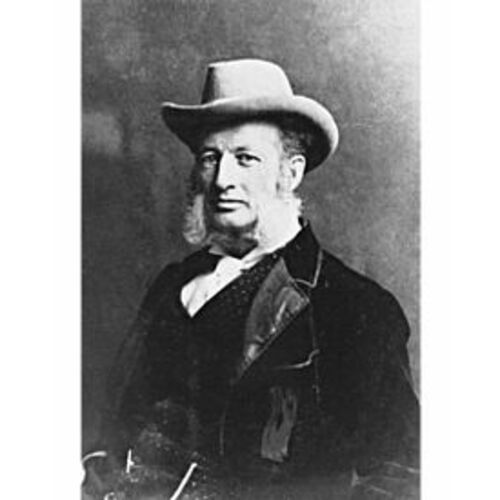
Source: Link
O’BRIEN, LUCIUS RICHARD, artist, educator, businessman, and politician; b. 15 Aug. 1832 at The Woods, Kempenfelt Bay, near Barrie, Upper Canada, the second of six children of Edward George O’Brien* and Mary Sophia Gapper; m. first 1860 Margaret St John in Orillia, Upper Canada (d. 10 Nov. 1886); m. secondly 17 Nov. 1888 Katherine Jane Parker, née Brough, in Toronto; there were no children from either marriage; d. 13 Dec. 1899 in Toronto.
Although Lucius Richard O’Brien was raised in the backwoods at what became Shanty Bay, his parents instilled in him a sense of culture and of social responsibility appropriate to their perceived station (his mother was of landed gentry and his father, in addition to being a retired army officer prominent in Simcoe County, was a second cousin of Sir Lucius O’Brien, the future Baron Inchiquin). One of the earliest records of young Dick, as he was known in the family, describes his interest in drawing, an interest he likely pursued as a student at Toronto’s Upper Canada College (1844–46), where he studied drawing, perhaps under John George Howard*, an architect and engineer. O’Brien is reported to have entered an architect’s office in 1847, and to have later studied and then practised civil engineering.
The first public evidence of O’Brien’s work as an artist is an engraving in The emigrant churchman in Canada (1849). In December 1850 he advertised in Toronto as a drawing-master and in October 1851 he showed a landscape drawing in the Toronto Mechanics’ Institute annual exhibition. Over the next few years he prepared drawings, usually of an architectural nature, for a number of Toronto engravers and lithographers, he continued to exhibit (he won two prizes for drawings in the professional category of the Upper Canada Provincial Exhibition, at Hamilton, in 1853), and throughout 1854 he was employed as drawing-master at a Toronto girls’ school. A sketchbook contains dated drawings done around Shanty Bay from 1852 through 1859. Listed as an artist in the 1856 Toronto directory, he then moved to Orillia, probably the following year, to manage a family-owned quarry. A member of the Orillia council (1858–61), he served as the village’s reeve (1859 and 1861) and as churchwarden at St James (1859-61 and 1863–64). By 1866 he was running a general store.
Following his marriage in 1860 to a local woman, O’Brien put aside his sketch-book. When he picked it up again in October 1868 it was to sketch on familiar ground near Orillia. By the following January, however, he was recording scenes around Montpellier, France, and early in April at Bulford in Wiltshire, England, where his mother’s family had its estate. On returning to Canada the same year he settled in Toronto, where he is listed in the 1870 directory as an associate of Quetton St George and Company, general merchants and importers of Mediterranean produce, with extensive interests at Montpellier. Despite the evidence of sketches from the Montpellier trip, O’Brien’s connection with this firm appears to have been mercantile rather than artistic. He became active in Toronto art circles once again, and in January 1873 he joined the fledgling Ontario Society of Artists, participating in its inaugural exhibition that April. The following year he was chosen to replace the disputatious John Arthur Fraser as vice-president of the society, a post he filled with distinction until 1880, when he was replaced by Robert Harris*. O’Brien’s most important achievement as vice-president was the establishment of the Ontario School of Art in 1876 under the society’s auspices. In addition to teaching water-colour painting at the school, he served on its council until 1879, when he essentially took over its running as one of a management team of three.
There is no single explanation for O’Brien’s sudden rise at the age of 42 to pre-eminence in the artistic world of Toronto. Certainly, the social connections he enjoyed through both his family and his business associates, combined with an aristocratic bearing and decisive manner, gave him the air of a leader. On the other hand, although there is no evidence he ever formally studied painting, the work he exhibited almost from the moment he returned to Canada in 1869 is skilful, highly polished, and reflects a knowledge of the concerns and standards of recent British water-colour landscape painting.
O’Brien worked in water-colour during the first few years, exhibiting large, spacious, light-filled images of small-boat activity on the waterways of Ontario. Like Under the cliffs, Port Stanley (1873), in a private collection, they are all harmoniously balanced, delicate yet vitally solid pictures of strong feeling. Built up of little dabs of colour, densely packed in some areas, more open and lighter in others, they present a striking quality of subtly changing, form-enhancing light. This technique was used by certain of the Pre-Raphaelites and their followers in England after mid century, such as William Holman Hunt, John Frederick Lewis, and Myles Birket Foster. However, the pervasive order and measured forms evident in O’Brien’s pictures relate more closely to the often-published topographical views of a generation earlier, although his English near-contemporary John Mogford reveals a similar concern for proportion and precise placement in his work, as well as a predilection for shoreline scenes. Some of the similar watercolours painted at the time by Henry Sandham*, in Montreal, are highly accomplished, and Allan Aaron Edson*, also of Montreal, working in a looser, more painterly water-colour technique, has left memorable work, but no one in Toronto could rival O’Brien, a fact that was noted in every exhibition review of the day.
Following a taste that had persisted since the time of Paul Kane*, O’Brien often included Indians in his pictures of the seventies. They are not the romantic figures of Kane, however, but are naturalistically rendered as co-inhabitants of the waterways, a part of the contemporary provincial scene. A landscape painter with an abiding interest in water (he loved sailing and boats in general), O’Brien clearly felt a calling to reflect the majestic beauty of his native land, and to that end he spent much of his summers travelling and sketching. In 1873 he visited the Ottawa region, Owen Sound, and Lake Erie, apparently returning the following year to lakes Erie and Huron. In 1875 and 1876 he went back to the Ottawa valley. Also in 1876 he visited the Philadelphia Centennial International Exhibition, where six of his large watercolours were included in the Canadian section of the fine arts display. Doubtless inspired by the European and American art there, he began to exhibit oils the following spring.
In 1877, after the new Intercolonial Railway had opened up the Baie des Chaleurs region of New Brunswick, O’Brien was among the first Toronto artists to travel there for sketching. He also spent time at Gloucester, Mass., and possibly New York City, that year. This ever-expanding horizon – so closely reflecting growing Canadian ambitions in general – drew him in 1878 to Grand Manan Island, in the Bay of Fundy. That year he also first exhibited with the National Academy of Design, in New York. In February 1879 he was in Boston studying art schools on behalf of the Ontario Department of Education, and in Ottawa seeking the patronage of the new governor general, the Marquess of Lorne [Campbell*], for the OSA. That summer he passed mainly at Quebec City, sketching there and as far afield as the Rivière Saguenay.
As in his water-colours, O’Brien could describe light and atmosphere in his oils with remarkable precision and beauty. Based on the same small graphite and water-colour field studies as his large, studio-painted water-colours, his earliest oils, such as Natural arches, near Dalhousie, N.B. (1877), in the collection of the Art Gallery of Ontario, are similar in almost all respects – in theme, composition, sense of form, of light, and even in method of applying the paint in small strokes – to his large water-colours. He was soon exploiting the particular characteristics of the medium, however, and Northern Head of Grand Manan (1879), first owned by George Brown* and now in the AGO, displays a grander scale, a more dramatic use of contrast of light and shadow, and a virtuoso command of a complex range of atmospheric conditions. Verging on the sublime, the painting reflects a view of landscape ultimately dependent upon the great English master of the early years of the century, J. M. W. Turner, but Turner as championed and interpreted by the English critic John Ruskin in his influential Modern painters (1843–60). Work of such scale, drama, and skill had never before been seen in Toronto.
The Royal Canadian Academy of Arts was established by Lorne in 1880, and O’Brien became its first president, a position he held for ten years. He had been actively seeking a national status for the Ontario Society of Artists with Lorne’s predecessor, Lord Dufferin [Blackwood*], but had no difficulty now channelling his aspirations through this new body, especially with the vice-regal patronage it enjoyed. Lorne, in turn, valued O’Brien’s leadership qualities and his pre-eminence among Canadian artists. Integral to the concept of a Canadian academy was the establishment of a national gallery through the deposit of a “diploma” picture by each academician. O’Brien’s contribution, Sunrise on the Saguenay (1880), dominated the academy’s first exhibition, which opened in Ottawa in March 1880, and has been a prominent feature of the National Gallery of Canada’s collection ever since. His largest canvas, it introduced a striking use of diaphanous, pastel colours in a manner similar to that employed by Albert Bierstadt, a popular American painter whom O’Brien had come to know through both Dufferin and Lorne. In addition to purchasing a few paintings for the royal collection from this first exhibition, Lorne did not hesitate to take the more risky route of commissioning two new pictures from O’Brien, dramatic views of Quebec City that now hang in Buckingham Palace.
When Picturesque Canada, the most ambitious publishing project of the time, was launched in 1880 [see George Monro Grant*], no one was surprised that O’Brien was chosen to be art editor; the appointment was calculated both to instil public confidence in the undertaking and to attract the support of other Canadian artists. The fact that the project was based on a successful American model and, indeed, was a business venture of two Americans, the Belden brothers from Chicago, Howard Raymond and Reuben Booth, necessitated an emphasis on Canadian involvement. The publication, which bore a Toronto imprint, was initially promoted as being entirely the work of Canadian writers and artists, although of the approximately 540 illustrations that graced its two volumes on completion in 1884, less than a quarter were by Canadians and almost all of these were by O’Brien; the remainder were done by Americans who had worked on the earlier book. This action, based on the backers’ claim that Canadian artists were not experienced enough in preparing work for the engraver, provoked bitter public dispute, and John Fraser in particular took great exception to the manner in which he had been virtually excluded from the project.
O’Brien’s income from the venture allowed him in 1881 to begin building an imposing new studio-home, designed by Frank Darling*, and gave him the courage to leave his position with Quetton St George and Company and finally devote himself full time to his painting. The following year the Ontario School of Art was taken into the provincial education system, owing largely to his efforts, and he served on its new council for two more years.
O’Brien continued to travel through these busy years: to Ottawa in March 1880 for the first exhibition of the academy, to England in June, probably on Picturesque Canada business, and back to Canada in August to gather material at Quebec for the two paintings commissioned by Lorne for the queen. In 1881, with Picturesque Canada taking most of his energy, he sketched around the Great Lakes. The year following he showed a large canvas, Kakabeka Falls, Kamanistiquia River (now in the NGC), the last oil he would exhibit for 12 years. There is no apparent reason why O’Brien stopped painting oils in 1882 after only five years at the practice. His large canvases are wonderfully conceived, heroic landscapes, executed with great skill and sensitivity to the medium, and they were popular in their day. In March 1882 he completed a third commission from Lorne and spent most of the summer sketching at Quebec, up the Saguenay, and down the lower St Lawrence as far as Gaspé.
Perhaps emboldened by the success of Picturesque Canada, which had been appearing in parts for about one and a half years, and encouraged by Lorne’s patronage, O’Brien spent from June to November 1883 in England again, arranging to leave some work with a dealer, travelling to Windsor to see one of his paintings in the royal collection, and sketching in Devon, partly to prepare illustrations for an article in one of the London periodicals. The trip culminated with his prominent inclusion in an exhibition of Canadian and American landscapes held by a dealer who specialized in such material. The final parts of Picturesque Canada appeared early in the fall of 1884 (O’Brien completed some British Columbia drawings for it from photographs). He had benefited greatly from the experience, both financially and in the development of his drawing skills. The public dispute with Fraser early in the project over the small involvement of Canadian artists other than O’Brien was bitterly personal, but O’Brien, with his remarkable self-control and aristocratic bearing, emerged unscathed. He seems to have spent part of the summer of 1884 sketching again on the Saguenay, and the following summer in familiar haunts throughout the upper Great Lakes.
Reviewers at mid decade noted a change in O’Brien’s water-colour style. One typified the recent work as “dreamy, poetical, harmonious, and tender,” and no longer “crisp,” as he preferred. Moreover, O’Brien does not appear to have been producing as many paintings as he had in the early 1880s. He did maintain his public profile, however, with an advertised open studio every Saturday afternoon.
When the officers of the Canadian Pacific Railway, in particular William Cornelius Van Horne*, decided to send artists west on their newly completed line in 1886 in order to promote the mountains as a tourist destination, O’Brien naturally was the first to be invited. (He had done some illustration work for the CPR as early as 1883.) He left Toronto on 19 June with another Toronto artist, his friend John Colin Forbes, travelling directly to the Selkirks, in which region he passed the summer. O’Brien travelled west on the CPR on two more occasions. In 1887 he sketched from late June to mid August in the Banff, Lake Louise, and Kicking Horse Pass regions of the Rocky Mountains, and then worked his way west, reaching Victoria in September; he was home by the end of October. In June 1888 he went straight to Vancouver and spent the whole summer in Howe Sound and vicinity, travelling with two Chinook guides in a sailing canoe.
O’Brien’s mountain and west coast work reveals him as again in full command of his powers as a painter. All water-colours, although in some cases very large sheets, these works are finely detailed but have a sweep to the composition that establishes the grand scale of the landscape subjects. Views of breath-taking mountain passes, such as Through the Rocky Mountains, a pass on the Canadian highway (1887), now in a private collection, and of the lush rain forests of the coast, as A British Columbian forest (1888, NGC), caught the imagination of Canadians, satisfying their sense of the nation as a newly accessible resource of boundless natural wealth. Prominently included in the Canadian section of the Colonial and Indian Exhibition, held in London in 1886, O’Brien had one of his mountain water-colours accepted by the Royal Academy of Arts, of London, in 1887, and over the following two years showed his water-colours in various exhibitions there. In Canada he was featured with Frederic Marlett Bell-Smith* in a two-man exhibition of mountain work at the Art Association of Montreal in March 1888, and in February 1889 his Howe Sound water-colours were part of a special AAM exhibition. Encouraged by the renewed attention, he left on another extended trip to London, principally to attend his first one-man exhibition, a show of Rocky Mountain and Pacific coastal scenes that opened on 22 June.
O’Brien’s water-colours of this period, often large, heavily worked and detailed pieces displaying nevertheless a sweep and scale that is commanding on a wall, reveal a concern evident for some time among the major British water-colourists to compete directly with oil paintings in the exhibitions. He sold a number of works from his show and received brief, approving notice in the London newspapers. This attention did not mark his entrée into the London scene, however, and most of the names on a guest-list that has survived reflect connections he had maintained with Lord Inchiquin, Lord Dufferin, the Marquess of Lorne, and the influential officers of the CPR.
O’Brien retired from the presidency of the RCA in 1890 and opened his own informal art school, the Studio Drawing Club. During the summer he returned to sketching at Quebec and along the lower St Lawrence for the first time in eight years. In December he held a one-man exhibition in Toronto, an event repeated annually through 1894. He resigned from the Ontario Society of Artists in January 1892 to protest a perceived lowering of standards in the annual exhibitions. In March he held a one-man exhibition in Montreal and engaged a New York dealer, whom he visited in September. His studio teaching was established on a more formal basis in 1893, the year he formed the Palette Club, an exclusive exhibiting association that staged two shows in 1893 and two more in 1894 in an attempt to promote the standards he felt were lacking in the OSA. O’Brien began exhibiting oils again that year, light-filled, atmospheric canvases of modest size. His water-colour painting became increasingly wet in handling, the broad washes revealing as much skill as the fine detail of his earlier work. In the summer he sketched again on Grand Manan. The following April he was back in New York, and in November 1895, in Toronto, he was elected president of the short-lived Guild of Sculpture of Ontario, even though there is no evidence he ever carved or modelled.
That month a retrospective exhibition of O’Brien’s water-colours, held in Toronto, essentially marked the end of his career. He continued private teaching and sketched on the Severn River and at other places in the Barrie-Orillia region during the summers, but his last illustration work appeared in February 1896. In May he allowed himself to be re-elected to the OSA. He came down with an illness in February 1899 that left him unable to paint. An auction sale in May was meant to raise money for a trip south and then to the west coast, but he did not make it.
Following his death, O’Brien’s painting fell from favour entirely, although his long tenure as first president of the Royal Canadian Academy of Arts assured that his name would not be forgotten. His dedication to both the OSA and the RCA was essential to their establishment as vital cultural institutions in their respective communities. O’Brien’s most substantial legacy, however, is his painting, a body of work that has grown in importance through the years. It is only through his work that we can really understand how he dominated the Canadian art world for two full decades, forming a vision of Canada that defined a generation’s sense of nationhood and that reverberates in the Canadian consciousness still.
Lucius Richard O’Brien is the author of “Art education – a plea for the artizan,” Rose-Belford’s Canadian Monthly and National Rev. (Toronto), 2 (January–June 1879): 584–91. A number of his letters from the Rocky Mountains and British Columbia were published in the Globe, 15 July, 27 Aug. 1887, and in the Toronto Daily Mail, 29 July, 4 Sept. 1886, 16 Aug. 1888; some were reprinted in the Daily Colonist (Victoria), 11 Sept. 1887, and in the News Advertiser (Vancouver), 1 Jan. 1889. Among the primary sources of information on O’Brien’s career are the printed catalogues that accompanied the exhibitions mentioned in the text. Public institutions holding his paintings include the Vancouver Art Gallery; the Visual Records Division of the PABC; the Glenbow Museum; the Montreal Museum of Fine Arts; the Dept. of Fine and Decorative Arts of the N.B. Museum; the Agnes Etherington Art Centre, Queen’s Univ. (Kingston, Ont.); the National Gallery of Canada (Ottawa); the Documentary Art and Photography Division of the NA; and, in Toronto, the Art Gallery of Ontario, the Government of Ontario Art Coll. in the Ontario Legislature Building, and the Hist. Picture coll. at the MTRL.
AO, MS 199, M. S. [Gapper] O’Brien, journals; MU 2254. Art Gallery of Ontario, Curatorial files, L. R. O’Brien, scrapbook (photocopy); Library, L. R. O’Brien, studio journal. Canadian Pacific Arch. (Montreal), Van Horne com Museum of Fine Arts (Boston), Corr. of the director, C. G. Loring, L. R. O’Brien to Loring, 4 March 1879 (mfm. at Arch. of American Art, Smithsonian Institution, Washington). NA, MG 28, I 126. PABC, Visual Records Division, pdp 2821. Private arch., Isabel Grant (Shanty Bay, Ont.), L. R. O’Brien, sketch-books (on extended loan to the Art Gallery of Ontario). Simcoe County Arch. (Minesing, Ont.), Orillia municipal council minutes, 18 Jan. 1858, 17 Jan. 1859, 21 Jan. 1860, 21 Jan. 1861. UTA, A74-0018/94; 0018/96. American Art Annual (Boston), 3 (1900–1): 59. Canadian Agriculturist (Toronto), 5 (1853): 336. M. [S. Gapper] O’Brien, The journals of Mary O’Brien, 1828–1838, ed. Audrey Saunders Miller (Toronto, 1968). “Guild of Sculpture of Ontario,” Canadian Architect and Builder (Toronto), 9 (1896): 77. [A. W. H. Rose], The emigrant churchman in Canada, by a pioneer of the wilderness, ed. Henry Christmas (2v., London, 1849). A selection of twenty-seven water colour drawings . . . by L. R. O’Brien . . . (London, [1889]). British Colonist (Toronto), 14 Oct. 1851. Daily Witness (Montreal), 13 Aug. 1889. Globe, 1854; 8, 15 Oct. 1881; 6 May 1899. Toronto Daily Mail, 11 Nov. 1886. Toronto Patriot, 20 Dec. 1850. Vancouver Daily World, 27 Aug. 1889. Week, 5 March 1885; 8 March 1888; 6 July, 14 Dec. 1894; 22 Nov. 1895. Appletons’ cyclopædia (Wilson et al.). Canada, an encyclopædia (Hopkins), 4: 400. Canadian men and women of the time (Morgan; 1898). Cyclopædia of Canadian biog. (Rose and Charlesworth), vol.1. Algernon Graves, A dictionary of artists who have exhibited works in the principal London exhibitions from 1760 to 1893 (London, 1901); The Royal Academy of Arts . . . (8v., London, 1905–6; repub. in 4v., East Ardsley, Eng., 1970), 6: 4. Harper, Early painters and engravers. Montreal Museum of Fine Arts, formerly Art Association of Montreal; spring exhibitions, 1880-1970, comp. E. de R. McMann (Toronto, 1988). Maria Naylor, The National Academy of Design exhibition record, 1861–1900 (2v., New York, 1973). Royal Canadian Academy of Arts; exhibitions and members, 1880–1979, comp. E. de R. McMann (Toronto, 1981). Simcoe County directory, 1866–67. Toronto directory, 1856, 1859, 1870–72, 1882. S. M. Briant, “The work of Lucius R. O’Brien in Picturesque Canada” (m.Museology thesis, Univ. of Toronto, 1977). C. T. Currelly, I brought the ages home (Toronto, 1956). The first hundred years: the story of St. James’s parish, Orillia (Orillia, Ont., 1941), 35. N. [McF.] MacTavish, Ars longa (Toronto, 1938). Edmund Morris, Art in Canada: the early painters ([Toronto, 1911]). D. A. Pringle, “Artists of the Canadian Pacific Railroad, 1881–1900” (ma thesis, Concordia Univ., Montreal, 1983). D. [R.] Reid, Lucius R. O’Brien, P.R.C.A. (forthcoming, Toronto, 1990); “Our own country Canada”. Robertson’s landmarks of Toronto, 3: 593. Rebecca Sisler, Passionate spirits; a history of the Royal Canadian Academy of Arts, 1880-1980 (Toronto, 1980). [D.] A. Pringle, “William Cornelius Van Horne, art director, Canadian Pacific Railway,” Journal of Canadian Art Hist. (Montreal), 8 (1984–85): 50–78. D. E. Walker, “Some early British Columbia views and their photographic sources,” Beaver, outfit 314 (summer 1983): 44–51.
Cite This Article
Dennis Reid, “O’BRIEN, LUCIUS RICHARD,” in Dictionary of Canadian Biography, vol. 12, University of Toronto/Université Laval, 2003–, accessed December 30, 2025, https://www.biographi.ca/en/bio/o_brien_lucius_richard_12E.html.
The citation above shows the format for footnotes and endnotes according to the Chicago manual of style (16th edition). Information to be used in other citation formats:
| Permalink: | https://www.biographi.ca/en/bio/o_brien_lucius_richard_12E.html |
| Author of Article: | Dennis Reid |
| Title of Article: | O’BRIEN, LUCIUS RICHARD |
| Publication Name: | Dictionary of Canadian Biography, vol. 12 |
| Publisher: | University of Toronto/Université Laval |
| Year of publication: | 1990 |
| Year of revision: | 1990 |
| Access Date: | December 30, 2025 |





